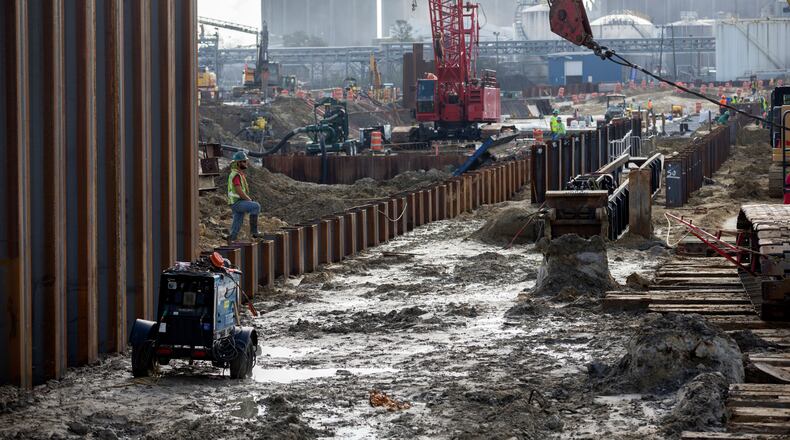The Port of Savannah, already in the midst of a rapid expansion, intends to add nearly 30% more capacity than originally planned, officials said Thursday.
The dramatically scaled-up plans coincide with record U.S. cargo volumes and pandemic-related supply chain problems that created major bottlenecks at many coastal ports much of last year. It’s also the latest sign that Georgia is becoming an increasingly important hub for transporting goods thanks to its sea, rail and air networks and growing population.
Now the second-largest port on the East Coast, Savannah is currently on track to expand its capacity to 7.5 million shipping containers a year. The new goal is to reach 9.5 million in the next three years, said Griff Lynch, executive director of the Georgia Ports Authority.
“We’ve always had a buffer, more capacity than demand,” Lynch told The Atlanta Journal-Constitution. “That buffer has been eliminated and we want to get out ahead of things again.”
Last year, about 5.6 million containers passed through Savannah, roughly 20% more than in 2020. Most of the cargo was incoming, not outgoing, amid a large trade deficit.
The centerpiece of the plan announced Thursday is a $200 million development at the Garden City Terminal that will include container storage, 30 new cranes, truck lanes and gates, Lynch said. “Over the next 10 years we are going to invest about $3 billion in our ports.”
The work on the terminal, which will be put out for bid, will be paid for with a combination of cash flow from the port’s business and hundreds of millions of dollars raised by selling bonds, he said.
The move to further expand the port comes after nearly two years of a pandemic-stoked flood of imports, sparked by a shift of consumer spending from services to goods.
A flurry of moves last year has alleviated most of the congestion, Lynch said.
But with trade through Savannah increasing for 18 consecutive months, more than 30 ships waited at anchor in the harbor to be unloaded at times last year. After being unloaded, containers were stacked high in the yard for weeks waiting to be carted away by truck or train.
The snarls raised costs and have plagued the economy with scattered shortages.
Scrambling to relieve the congestion, the authority hired more workers and had much of its workforce going overtime. To move and store containers, officials opened new rail lines, while using federal funding to add four inland holding areas for containers late last year, one of them in the Reynoldstown neighborhood of Atlanta.
Two more inland yards have since been added, and as of Thursday, unloading had caught up with the backlog and there were no ships in queue to be unloaded, Lynch said.
Savannah is now the fourth-largest container port in the nation. On the East Coast, only the Port of New York and New Jersey is larger.
Like the nation overall, Georgia runs a huge trade deficit.
Georgia has become the seventh-largest state for imports, bringing in $98.8 billion worth of goods last year, the lion’s share of it from China, according to the Census Bureau. Georgia ranked 11th among U.S. states for exports, sending $40.6 billion abroad.
Nationally, imports have grown in the past five years from $2.7 trillion to $3.4 trillion. Exports have also grown, but not as fast. As a result, the country’s trade deficit has ballooned from $481.5 billion to $859.1 billion.
Even before the pandemic, efforts to expand the Savannah port’s capacity were underway, including a federally led project to deepen the harbor to permit larger ships.
“We are 19 days away from finishing that 20-year odyssey,” Joel Wooten, chairman of the port authority board, told the AJC. “That is a big, big milestone.”
The expansion of the port has paralleled a surge in Georgia jobs in warehouses, distribution and transit. Much of the growth is close to the port, Lynch said.
“The public and private investment that we’re seeing, as well as the number of people being drawn to the business, make Savannah the hottest market in the country for transportation and logistics,” he said.
Largest ports, ranked by number of containers* handled, 2021:
Los Angeles
Long Beach
New York/New Jersey
Savannah
Seattle/Tacoma
Houston
Virginia
Oakland
Charleston
Jacksonville
*Measured in 20-foot containers.
Source: U.S Department of Transportation
_________________
Largest importing states:
California
Texas
Illinois
Michigan
New York
New Jersey
Georgia
Pennsylvania
Tennessee
Florida
Largest exporting states:
Texas
California
New York
Washington
Louisiana
Illinois
Michigan
Florida
Ohio
Pennsylvania
Georgia
Source: Census Bureau
About the Author
Keep Reading
The Latest
Featured



